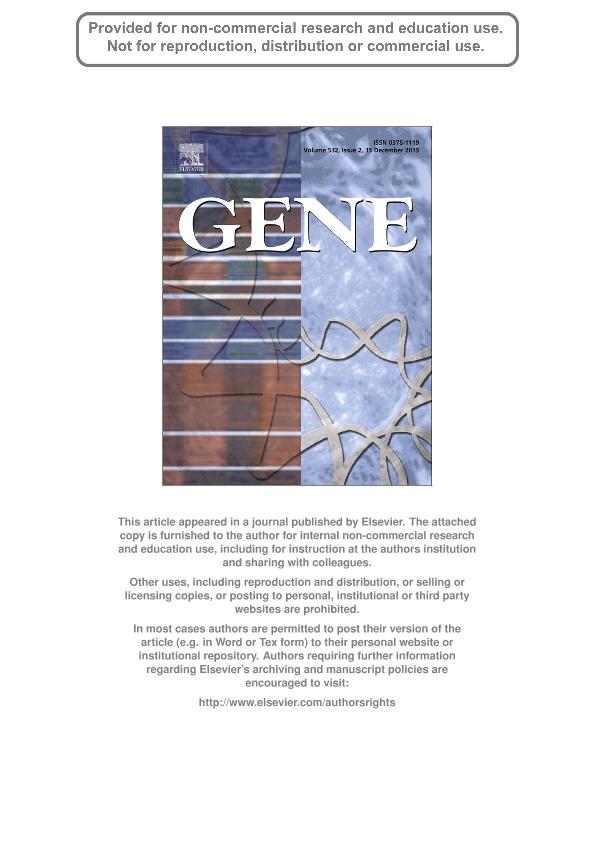Artículo
Uncoupling of osteoblast-osteoclast regulation in a chemical murine model of Gaucher disease
Mucci, Juan Marcos ; Suqueli García, María Florencia
; Suqueli García, María Florencia ; de Francesco, Pablo Nicolás
; de Francesco, Pablo Nicolás ; Ceci, Romina; Di Genaro, S.; Fossati, Carlos Alberto
; Ceci, Romina; Di Genaro, S.; Fossati, Carlos Alberto ; Delpino, María Victoria
; Delpino, María Victoria ; Rozenfeld, Paula Adriana
; Rozenfeld, Paula Adriana
 ; Suqueli García, María Florencia
; Suqueli García, María Florencia ; de Francesco, Pablo Nicolás
; de Francesco, Pablo Nicolás ; Ceci, Romina; Di Genaro, S.; Fossati, Carlos Alberto
; Ceci, Romina; Di Genaro, S.; Fossati, Carlos Alberto ; Delpino, María Victoria
; Delpino, María Victoria ; Rozenfeld, Paula Adriana
; Rozenfeld, Paula Adriana
Fecha de publicación:
10/2013
Editorial:
Elsevier Science
Revista:
Gene
ISSN:
0378-1119
Idioma:
Inglés
Tipo de recurso:
Artículo publicado
Clasificación temática:
Resumen
Gaucher disease (GD) is caused by mutations in the GBA gene that confer a deficient level of activity of glucocerebrosidase (GCase). This deficiency leads to accumulation of the glycolipid glucocerebroside in the lysosomes of cells ofmonocyte/macrophage system. Type I GDis the mildest formand is characterized by the absence of neuronopathic affection. Bone compromise in Gaucher disease patients is the most disabling aspect of the disease. However, pathophysiological aspects of skeletal alterations are still poorly understood. The homeostasis of bone tissue ismaintained by the balanced processes of bone resorption by osteoclasts and formation<br />by osteoblasts. We decided to test whether bone resorption and/or bone formation could be altered by the use of a chemical in vitro murine model of Gaucher disease.<br />We used two sources of cells from monocyte/macrophages lineage isolated from normal mice, splenocytes (S) and peritonealmacrophages (PM), and were exposed to CBE, the inhibitor of GCase (S-CBE and PM-CBE, respectively).<br />Addition of both conditioned media (CM) from S-CBE and PM-CBE induced the differentiation of osteoclasts precursors from bone marrow to mature and functional osteoclasts. TNF-α could be one of the factors responsible for this effect. On the other hand, addition of CM to an osteoblast cell culture resulted in a reduction in expression of alkaline phosphatase and mineralization process. In conclusion, these results suggest implication of changes in both bone formation and bone resorption and are consistent with the idea that both sides of the homeostatic balance are affected in GD
Palabras clave:
Gaucher
,
Osteoblast
,
Osteoclast
,
Rankl
Archivos asociados
Licencia
Identificadores
Colecciones
Articulos(INIGEM)
Articulos de INSTITUTO DE INMUNOLOGIA, GENETICA Y METABOLISMO
Articulos de INSTITUTO DE INMUNOLOGIA, GENETICA Y METABOLISMO
Citación
Mucci, Juan Marcos; Suqueli García, María Florencia; de Francesco, Pablo Nicolás; Ceci, Romina; Di Genaro, S.; et al.; Uncoupling of osteoblast-osteoclast regulation in a chemical murine model of Gaucher disease; Elsevier Science; Gene; 532; 2; 10-2013; 186-191
Compartir
Altmétricas



